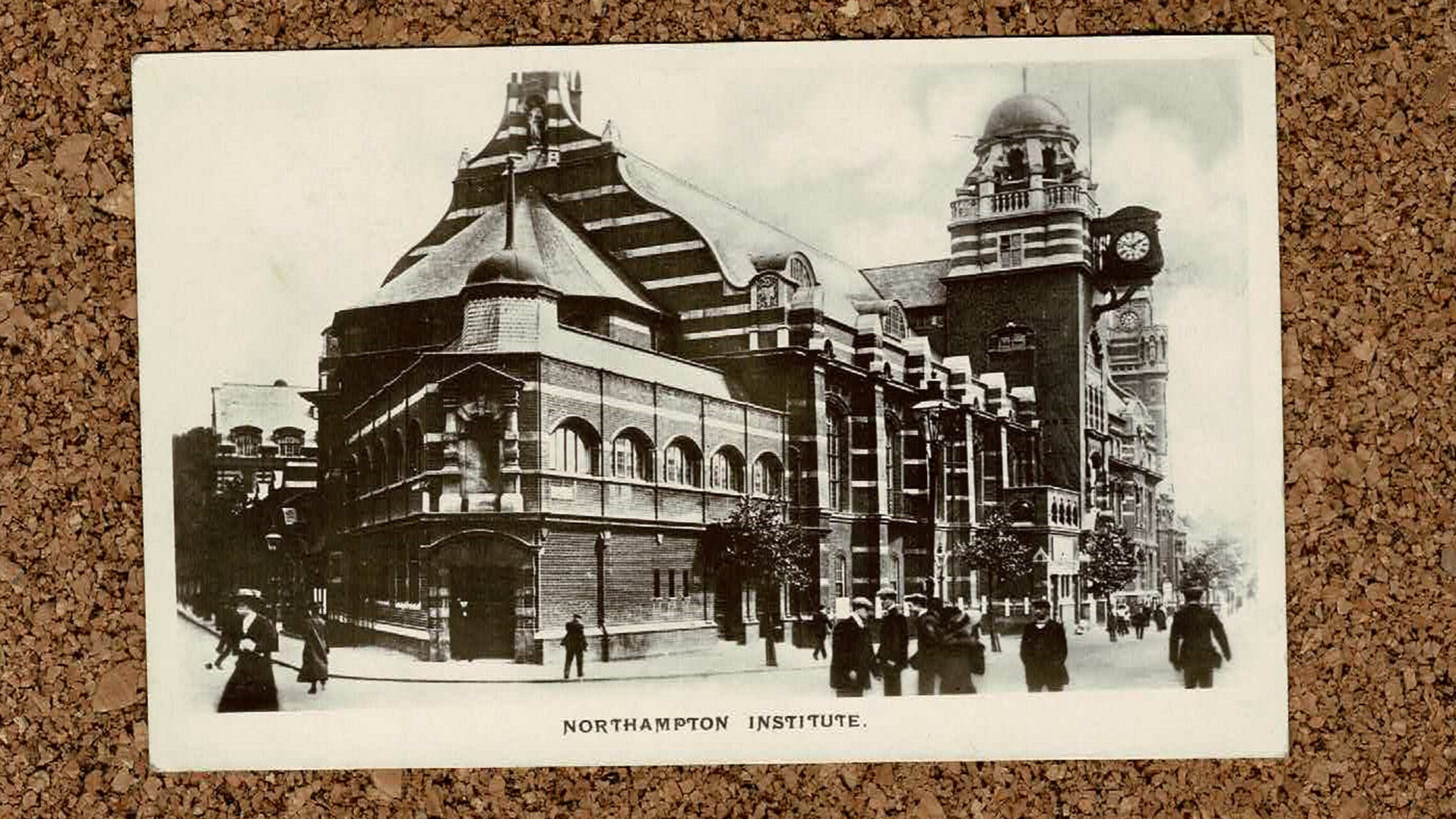Greetings from London. Yes, London. Not Northampton. No.
The Northampton Institute was founded in 1894, in land off St John Street, Clerkenwell, donated by the Marquess of Northampton. Its objects included promoting “the industrial skill, general knowledge, health and wellbeing of young men and women belonging to the poorer classes”.
Its early subjects included Mechanical Engineering and Metal Trades; Artistic Crafts for Industry; Applied Physics and Electrical Engineering; Horology; Electro-chemistry; and Domestic Economy. The college building, shown in the card, was opened in 1898.
It included a swimming pool, which was one of the venues for the 1908 London Olympics, along with the Great Hall, at which the boxing was held. It also has a clock tower, the peal of the bells of which, being in the Westminster pattern, was reputedly in the second world war a broadcast backup for the chimes of Big Ben, in the event that this was damaged by bombing.
(I worked at City from 1997 to 2004 and at one point had an office very near the clock and bells. You got used to the chimes, to the point of forgetting that they were there. On more than one occasion I ‘phoned someone just before 12, and we both then had a minute’s awkwardness whilst the bongs prevented any conversation.)
The early years of the twentieth century saw the addition of optics and aeronautical engineering to the Institute’s studies.
In 1924 the founding Principal of the Institute, Robert Mullineux Walmsley, was killed in a road collision on St John Street – legend has it, by a number 38 bus. 75 years later we used a standard question in course approval, which was, what happens if the course director was hit by a bus? History’s echoes are always around us.
Students took University of London degrees as Internal Students (the Institute being an ‘Institution having Recognised Teachers’), and its reputation grew. Its aeronautics department’s staff included Frederick Handley Page, pioneer of British aircraft design. Another notable name was Oleg Kerensky, son of the Aleksandr Kerensky, leader of the Russian Provisional Government between July and November 1917, who (Oleg not Aleksandr) studied at the Institute.
The Institute – by now the Northampton Polytechnic Institute, to be doubly confusing – was a pioneer in several fields. These included optics, as already noted, and information science, with the establishment in 1961 of a course on “Collecting and Communicating Scientific Knowledge”. In 1957 it was designated a College of Advanced Technology, and in 1966 it gained a royal charter.
The naming of the new university was not without controversy. A name was needed which did not tread on the toes of any other institution, but eventually City University, London was chosen. The Lord Mayor in office of the City of London fulfils the senior ceremonial role – formerly the Chancellor, now known as the Rector – within the university.
The University continued to expand, with its Northampton square site gaining several buildings, the housing of its business school in the Barbican, and the establishment of music and journalism departments.
City was one of the institutions hit grievously by the 1981 budget, with a 25% reduction in government funding. The university pursued a policy of active development of taught master’s programmes, which enabled it to thrive; and a policy of devolution of funding and accountability to schools, which helped to mitigate risks. The then VC also, symbolically, removed the batteries from the clock outside his office, which stood still until in 1998, a new VC reversed that edict.
In 2001 a fire caught in the College building. The effect of this and the water used to extinguish the fire was very destructive. As one whose office was flooded but not burned, I can confirm that the experience was No Fun At All.
City did not only grow organically. In 1995 St Bartholomew’s School of Nursing and Midwifery and the Charterhouse College of Radiography joined the University; and in 2001 the Inns of Court School of Law joined the University.
(This latter expanded considerably the University’s alumni; and enabled it to claim, correctly, to have educated Mohandas K Gandhi, Margaret Thatcher and Tony Blair.)
In 2016 City went back to its roots, and became a college of the University of London. Its Vice-Chancellor became the President; its Chancellor the Rector; and its name changed with the switch of a comma and the addition of a preposition: City University, London became City, University of London.
I have a soft spot for City. I learnt a lot there, and was given opportunities which helped shape my career in many ways. I hope this blog is some small recognition of the debt I owe to a quirky but splendid institution.













“A name was needed which did not tread on the toes of any other institution, but eventually City University, London was chosen.” This is not correct, it was named ‘The City University’
Hi I read your article about Northampton Poly. I worked in Optometry 1979 -1985 as a Lab Tech and I used to swim during those year in the pool. It was over chlorinated most times and the bottom of the pool was very sharp to the feet it was then lined with a plastic. However I left and went to work at City & Islington College just down the road we jointly taught a Foundation Degree with City. I retired from the College in 2019 but am now a visiting lecturer at City Uni. My father was a technician in… Read more »